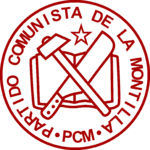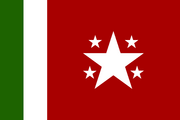Communist Party of Montilla
Communist Party of Montilla Partido Comunista de la Montilla | |
|---|---|
 | |
| Abbreviation | PCM |
| General Secretary | Vacant |
| Founders | Miguel Guerra Álvaro Santana Ramón Sáez |
| Founded | 2 February 1959 |
| Preceded by | Montillan Revolutionary Movement Workers' and Peasants' Party of Montilla |
| Newspaper | Acción Popular |
| Student wing | Vicente Manzanedo Student Movement |
| Youth wing | Union of Revolutionary Youth |
| LGBTQ+ wing | Martina Manzanedo Revolutionary Collective |
| Membership (2021) | 800,000 |
| Ideology | Communism Marxism-Leninism Left-wing nationalism Anti-imperialism Anti-fascism |
| Political position | Far-left |
| Colors | Red Green White |
| Slogan | ¡Obreros y campesinos del mundo, uníos! ("Workers and peasants of the world, unite!") |
| National Assembly | 550 / 550
|
| Flag of the Communist Party of Montilla | |
 | |
The Communist Party of Montilla (Spanish: Partido Comunista de la Montilla, PCM) is the sole ruling party of Montilla. It was founded 02 February 1959 as a successor of the guerilla organization Montillan Revolutionary Movement, the Workers' and Peasants' Party of Montilla and the National Liberation Front, which seized power in the 1958 Montillan Revolution. The Montillan constitution describes the party as the "leading force of society, the state and the revolution".
The highest body within the PCM is the Party Congress, which convenes every four years. When the Congress is not in session, the Central Committee is the highest body. Because the Central Committee meets once a year, most day-to-day duties and responsibilities are vested in the Political Council. Since March 2024, the role of General Secretary has been vacant, but it was previously held by Fernando Gallardo, also president of Montilla.
History
Montilla had a number of communist organizations from the start of the Third Republic (founded in 1898). One of the primary parties was the Workers' and Peasants' Party of Montilla (POCM), founded by union leaders, peasant leaders and radicalized members of the Radical Republican League (LRR) and the Republican Liberal Party (PLR) in 1921. The party suffered extensive state repression until it was banned in the government of Arturo Guillén in 1943, due to pressure from renovationalist and conservative sections of society. Despite going underground briefly, the party was completely dissolved after the Guaitiazo and the failed Yanagua Rebellion, divided into several guerilla groups and underground movements. After the overthrowing of Leonardo Murillo in the Montillan Revolution, the United Revolutionary Alliance (ARU) was created on 12 January 1959 from a merger of:
- Miguel Guerra's Montillan Revolutionary Movement
- Remnants of the Workers' and Peasants' Party of Montilla led by Álvaro Santana
- Parts of the National Liberation Front formed of social-democrats and democratic socialists, led by Ramón Sáez
On 02 February 1959, the creation of the new party was formalized as the United Alliance of the Socialist Revolution (AURPS), which later became the Communist Party of Montilla (PCM) on 05 June 1961. In Article 5 of the Montillan constitution of 1962, the Communist Party is recognized as the "the superior guiding force of society and of the State, that organizes and orients common efforts toward the high goals of the construction of socialism and the advancement toward communist society". All parties, including the Communist Party, are prohibited from publicly advertising their organizations.
Organization
Congresses
The Communist Party of Montilla held its first party Congress in 1960, and has had additional congresses each four years ever since. The Party Congress is usually televised nationally and traditionally held for two weeks in May. The next Party Congress is planned to happen in 2024.
Central Committee
The leading bodies of the party are the Politburo and the Secretariat, which make up the united Central Committee of the Communist Party, headed by the General Secretary. Miguel Guerra was the party's first General Secretary, followed by Diego Villa Simarro, Maria Alguacil, Alonzo Garrido and Fernando Gallardo. The role is currently vacant.
Political Council (Politburo)
A 14-strong Politburo was elected by the Plenary Session of the Central Committee on 20 April 2020 following the Party Congress.
Secretariat
A 6-strong Secretariat was elected by the Plenary Session of the Central Committee on 20 April 2020 following the Party Congress.
- Union of Revolutionary Youth, (UJR, founded in 1962 by Miguel Guerra), youth group of future militants of the PCM
- Worker's Central Union of Montilla, (CTM, founded in 1931 by Eduardo Volquemán and Mateo Nores), a Montillan trade union center
- Revolutionary Federation of Women's Power, (FRPF, founded in 1960 by Miguel Guerra and Martina Manzanedo), a centralized women's organization
- Revolutionary Pioneer Organization, (OPR, founded in 1970 by Miguel Guerra), student organization (pioneers)
- Vicente Manzanedo Student Movement, (ME-VM, founded in 1942 by Vicente Manzanedo, Miguel Guerra and Mario Beldad), student organization
- Committees for the Defense of the Revolution, (CDR, founded in 1961 by Miguel Guerra), community work organization
- Association of Combatants of the Montillan Revolution, (ACRM, founded in 1980 by Miguel Guerra), organization of active and retired military personnel
- Union of Journalists of Montilla, (UPEM, founded in 1962 by Miguel Guerra and Ramón Sáez), a centralized organization of journalists
- Association of Medicine of Montilla, (AMM, founded in 1960 by Miguel Guerra), a centralized organization for medical doctors
- Martina Manzanedo Revolutionary Collective, (CR-MM, founded in 1980 by Miguel Guerra and Martina Manzanedo), an organization for LGBTQ+ people
Ideology
The PCM is officially a Marxist-Leninist party that is dedicated to the establishment of communism. Since the Revolution, the party has adapted its policies and ideology to the Montillan reality, along with an ideology of exporting the revolution abroad through international worker solidarity and intervention of volunteer battalions, a policy abandoned in 2001.